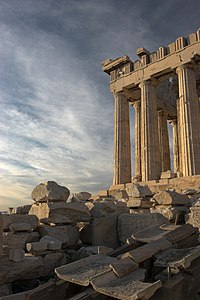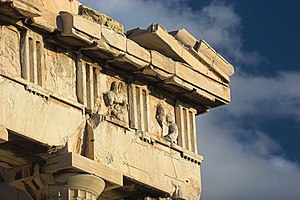___________________________________
Parthenon
From Wikipedia, the free encyclopedia
The Parthenon (Greek : Παρθενώνας) is the best-known surviving building of Ancient Greece and is regarded as one of the world's greatest cultural monuments. The building has stood atop the Acropolis of Athens for nearly 2,500 years and was built to thank the Greek goddess Athena , the city's patron goddess , for the salvation of Athens and Greece in the Persian Wars . The temple can also be seen as a political statement to the neighbours and visitors of Athens - a cultural milestone showing the richness and power of their city. The building was called the Temple of Athena the Virgin, and its popular name derives from the ancient Greek word παρθένος (parthenos), a virgin.
The Parthenon replaced an older building that had been destroyed by the Persians . As well as being a temple, the Parthenon was used as a treasury , and was the location of the treasury of the Delian League , which later became the Athenian Empire .
Contents[hide ] |
Design and construction
The Parthenon was built at the initiative of Pericles , the leading Athenian politician of the 5th century BC. It was built under the general supervision of the sculptor Phidias , who also had charge of the sculptural decoration. The architects were Iktinos and Kallikrates . Construction began in 447 BC, and the building was substantially completed by 438 BC, but work on the decorations continued until at least 433 BC. Some of the financial accounts for the Parthenon survive and show that the largest single expense was transporting the stone from Mount Pentelicus , about 16 kilometres from Athens, to the Acropolis. The funds were partly drawn from the treasury of the Delian League, which was moved from the Panhellenic sanctuary at Delos to the Acropolis In 454 BC.
Although the nearby Temple of Hephaestus is the most complete surviving example of a Doric order temple, the Parthenon, in its day, was regarded as the finest. The temple, wrote John Julius Norwich , "enjoys the reputation of being the most perfect Doric temple ever built. Even in antiquity, its architectural refinements were legendary, especially the subtle correspondence between the curvature of the stylobate , the taper of the naos walls and the entasis of the columns." The stylobate is the platform on which the columns stand. It curves upwards slightly for optical reasons. Entasis refers to the slight swelling of the columns as they rise, to counter the optical effect of looking up at the temple. The effect of these subtle curves is to make the temple appear more symmetrical than it actually is.
Measured at the top step, the dimensions of the base of the Parthenon are 69.5 meters by 30.9 meters (228.0 x 101.4 ft). The cella was 29.8 meters long by 19.2 meters wide (97.8 x 63.0 ft), with internal Doric colonnades in two tiers, structurally necessary to support the roof. On the exterior, the Doric columns measure 1.9 meters (6.2 ft) in diameter and are 10.4 meters (34.1 ft) high. The corner columns are slightly larger in diameter. The stylobate has an upward curvature towards its center of 60 millimeters (2.36 in) on the east and west ends, and of 110 millimeters (4.33 in) on the sides. Some of the dimensions form the golden rectangle expressing the golden ratio , praised by Pythagoras in the previous century.
Sculptural Decoration
The Parthenon, an octostyle , peripteral Doric temple with Ionic architectural features, housed the chryselephantine colossal statue of Athena Parthenos of the sculptor Pheidias dedicated in 439/438 B.C.. The temple itself was dedicated to the city-goddess at that time although construction works continued until almost the beginning of the Peloponnesian War in 432 B.C.. By the year 438 B.C., the sculptural decoration of the Doric metopes on the exterior colonnade and of the Ionic frieze on the upper exterior walls of the cella had been completed.
The 92 Doric metopes of Parthenon were carved in high-relief, a practice applied until then only in Treasuries (buildings used to keep votive gifts to the gods). The metopes, according to the building inscriptions, are dated in the years 446-440 B.C. and were all carved at the same date. It is supposed to have been designed by the sculptor Kalamis. The East metopes, above the main entrance, depict the Gigantomachy (the fight of the Olympian gods against the Giants), the West metopes the Amazonomachy (the mythical battle of the Athenians against the Amazons), the North metopes-with the exception of the somewhat problematic plaques No. 13-20, now lost- the Thessalian Centauromachy (the battle of the Lapiths aided by the city-hero Theseus against the half-man, half-horse Centaurs). Stylistically, the metopes present surviving traces of the Severe-Style in the anatomy of the figures'heads, in the limitation of the corporal movements to the contours and not to the muscles and in the presence of pronounced veins in the figures of the Centauromachy. Several of the metopes still remain on the building but with the exception of the ones in the northern side, they are severely damaged. Some of them are located at the Acropolis' Museum, others are in the British Museum and one can be seen at the Louvre Museum .
The most characteristic feature in the architecture and in the decoration of the temple is the existence of an Ionic frieze running on the exterior walls of the cella. Carved in bas-relief, it depicts an idealized version of the Panathenaic procession from the Dipylon Gate in Kerameikos to the Old Temple of Athena (Erechtheion) in the Acropolis. In this procession held every 4 years, Athenians and foreigners were participating to honour the goddess Athena offering sacrifices and a new peplos (dress woven by selected noble Athenian girls called ergastines). The entire frieze was carved in situ and it is dated in 442-438 B.C..
Pausanias , the 2nd century traveller, when he visited the Acropolis and saw the Parthenon, described only the pediments of the temple. The East pediment narrates the birth of Athena from the head of her father, Zeus , whereas the West pediment presents the dispute of Athena and Poseidon over the city of Athens . The work on the pediments lasted from 438-432 B.C..
The richness of the decoration in the temple of Parthenon is unique for a classical Greek temple. It is, however, in agreement with the function of the temple as a Treasury. In the opisthodomus (the back room of the cella), Parthenon kept the monetary contributions of the Delian Alliance of which Athens was the leading member.
Later history
The Parthenon survived as the most important temple of the Ancient Greek religion for close to a thousand years. It was certainly still intact in the 4th century AD, by which time it was already as old as Notre Dame Cathedral in Paris is now, and far older than St. Peter's Basilica in Rome . But by that time Athens had been reduced to a provincial city of the Roman Empire , albeit one with a glorious past. Sometime in the 5th century, the great cult image of Athena was looted by one of the Emperors, and taken to Constantinople , where it was later destroyed, possibly during the sack of the city during the Fourth Crusade in 1204.
Shortly after this, the Parthenon was converted to a Christian church . In Byzantine times it became the Church of the Parthena Maria (Virgin Mary), or the Church of the Theotokos (Virgin Mary ). At the time of the Latin Empire it became briefly a Roman Catholic Church of Our Lady . The conversion of the temple to a church involved removing the internal columns and some of the walls of the cella, and the creation of an apse at the eastern end. This inevitably led to the removal and dispersal of some of the sculptures. Those depicting gods were either re-interpreted according to a Christian theme, or removed and destroyed.
In 1456, Athens fell to the Ottomans , and the Parthenon was converted again, into a mosque . Contrary to subsequent mythology, the Ottomans were generally respectful of ancient monuments in their territories, and did not willfully destroy the antiquities of Athens, though they had no actual programme to protect them. However in times of war they were willing to demolish them to provide materials for walls and fortifications. A minaret was added to the Parthenon and its base and stairway are still functional, leading up as high as the architrave and hence invisible from the outside; but otherwise the building was not damaged further. European visitors in the 17th century, as well as some representations of the Acropolis hill testified that the building was largely intact.
In 1687, the Parthenon suffered its greatest blow when the Venetians attacked Athens, and the Ottomans fortified the Acropolis and used the building as a gunpowder magazine. On September 26 , a Venetian shell exploded the magazine and the building was partly destroyed. The internal structures were demolished, whatever was left of the roof collapsed, and some of the pillars, particularly on the southern side, were decapitated. The sculptures suffered heavily. Many fell to the ground and souvenirs were later made from their pieces. After this, much of the building fell into disuse and a smaller mosque was erected.
By the late eighteenth century, many more Europeans were visiting Athens, and the picturesque ruins of the Parthenon were much drawn and painted, helping to arouse sympathy in Britain and France for Greek independence. In 1801, the British Ambassador at Constantinople , the Earl of Elgin , obtained a firman (permit) from the Sultan to make casts and drawings of the antiquities on the Acropolis, to demolish recent buildings if this was necessary to view the antiquities, and to remove sculptures from them. He took this as permission to collect all the sculptures he could find. He employed local people to detach them from the building itself, a few others he collected from the ground, and some smaller pieces he bought from local people.
Today these sculptures are in the British Museum , where they are known as the Elgin Marbles or Parthenon Marbles . Other sculptures from the Parthenon are in the Louvre in Paris and in Copenhagen . Most of the remainder are in Athens, in the Acropolis Museum which stands below ground level, a few metres to the south-east of the Parthenon. A few can still be seen on the building itself. The Greek government has been campaigning for many years for the British Museum sculptures to be returned to Greece. The British Museum has steadfastly refused to consider this, and successive British governments have been unwilling to force the Museum to do so (which would require legislation). As the Greeks are working hard to conserve and reconstruct areas of the Acropolis to provide modern visitors with a life experience, a compromise should be possible using casts and/or reproductions.
When independent Greece gained control of Athens in 1832, the visible section of the minaret was removed from the Parthenon and all the medieval and Ottoman buildings on the Acropolis removed. The area became a historical precinct controlled by the Greek government. Today it attracts millions of tourists every year, who travel up the path at the western end of the Acropolis, through the restored Propylaea , and up the Panathenaic Way to the Parthenon, which is surrounded by a low fence to prevent damage.






